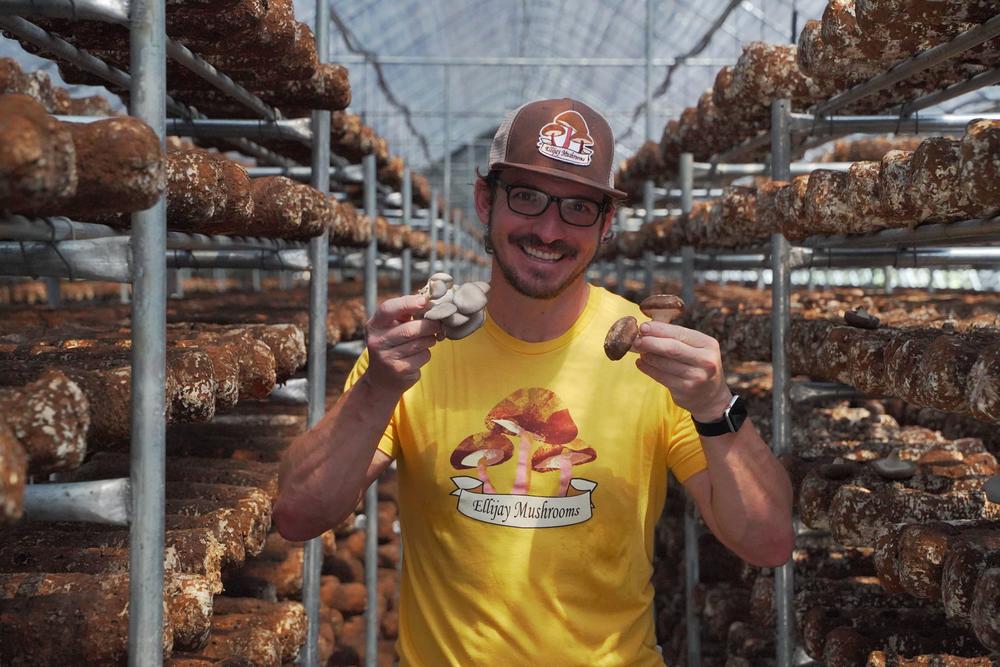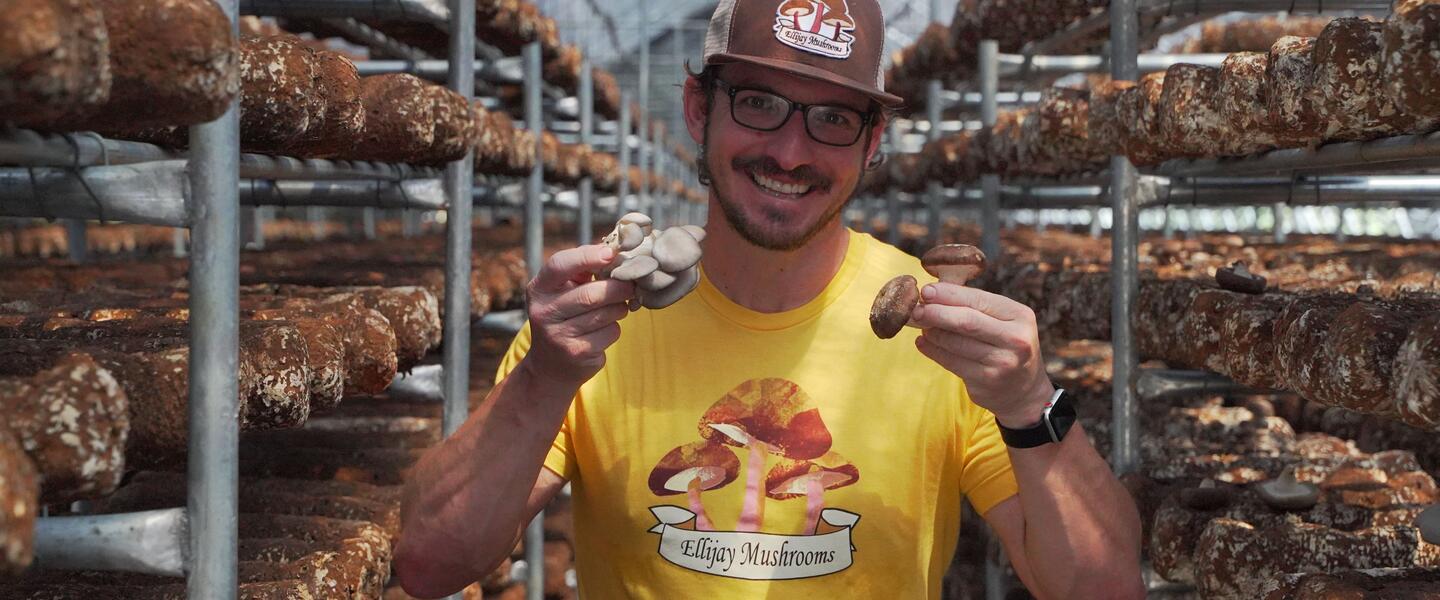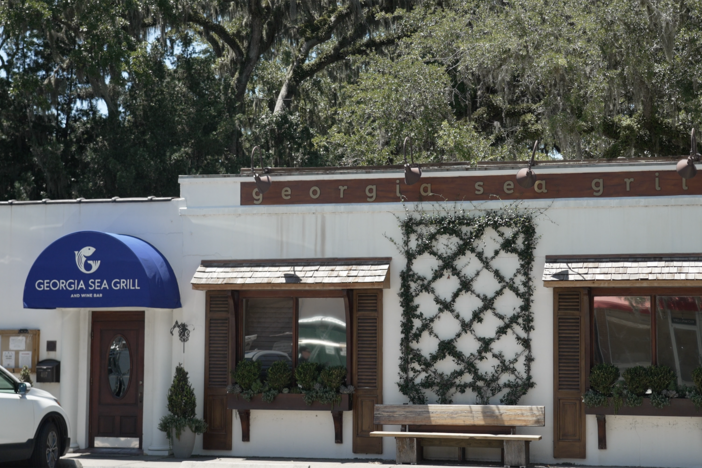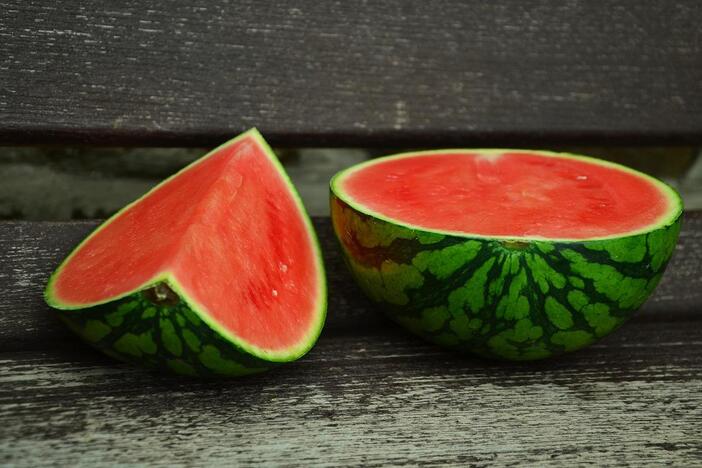
Section Branding
Header Content
A Fork in the Road Podcast: Ellijay Mushrooms
Primary Content
On this episode, we're in the home of the Georgia Apple Festival, Ellijay. But apples aren't the only thing being grown here. This mountain town is also home to Ellijay Mushrooms where you can find meaty, tasty, earthy mushrooms being grown with pristine mountain water.

Howard Berk: Besides being a fun guy. No, that's a mushroom joke. We have amazing water up here. The mountain water really makes our mushrooms stand out.
David Zelski: Today, we're headed north to the home of the Georgia Apple Festival, Ellijay. The north Georgia mountain town of Ellijay is quintessentially charming, welcoming visitors with its hiking trails, historic downtown and wineries. And yes, Ellijay is world famous for its apples, but they aren't the only thing being grown down here.
Howard Berk: These oyster mushrooms look so delicious.
David Zelski: The heart of Gilmer County is also where you'll find the 171 acres of Georgia farmland in the foothills of the Appalachian Mountains. That is the home to Ellijay Mushrooms.
Theme Song: I came from the mud, there's dirt on my hands. Strong like a tree, there's roots where I stand.
David Zelski: I'm David Zelski, and this is the Fork in the Road podcast, featuring the stories from Georgia's farmers, fishermen, merchants, artisans, chefs and others who help provide Georgia grown products to folks in the Peach State and beyond. Today, we will be hanging out with Howard Berk. He is one of the partners at Ellijay Mushrooms.
Howard Berk: Besides being a fun guy. No, that's a mushroom joke. I just love growing things. One thing led to another. I met my first mushroom partner with 2FunGuys when we started Chamblee's Farmers Market in 2011. With 2FunGuys we enable you to become a mushroom grower at home. In 2018, my partner here in Ellijay, Megan Cai, found me through that company and now we grow mushrooms commercially.
David Zelski: On this episode, Howard is going to walk us through the rows and rows of damp logs growing mushrooms in the greenhouses at Ellijay Mushrooms and give us the ins and outs of the operation.
Howard Berk: Yeah. So currently at Ellijay Mushrooms, we are growing two types of mushrooms. One, we are growing shiitakes, which we'll go see in a little bit. And right now we're in our oyster house. So our oyster mushrooms are grown in here and this is called pinning. So right now you can see the baby little mushrooms. These are little oyster mushrooms that have just came out of the log. Within the next 2 to 3 days, they will get to this next stage a little bit bigger and a little bit happier. About three more days later — so a total of 5 to 6 days — you'll have your mushrooms ready to harvest. These oyster mushrooms look so delicious. All you have to do is just twist it off this log, put it into a harvest basket, keep it in our refrigerator. You can order our mushrooms and then take it home and eat it. Have a great, healthy, yummy meal. Look how cool those oysters are. The gills are so pretty. So nice.
David Zelski: When Howard says they're so pretty and so nice, what is he looking for? And just how can he tell that it's a perfect mushroom?
Howard Berk: Really, just to have a good-sized oyster head, like the top of the cap before it starts flipping up, which would be when they drop their spores, which would be like this. So this oyster mushroom is still good. It just won't have as long as a shelf life compared to something that's a little bit tighter.
David Zelski: It always helps when someone can make it all sound so simple. Now that we know what to look for, let's talk about the why. Why are mushrooms so beneficial?
Howard Berk: Well, mushrooms are great in general. With oyster mushrooms, they're a good source of protein as well. They do great nutrients inside. But the main highlight, which we really like to talk about right now is the shiitake mushrooms.
AI Voice: The shiitake is an edible mushroom native to East Asia, which is now cultivated and consumed around the globe.
Howard Berk: Shiitakes are really, really special mushroom. Really high in vitamin D. They lower your blood pressure, lower your cholesterol. They have a lot of amino acids, the same as us, huge in protein, iron, zinc. So technically the other magic mushroom, they're just packed full of nutrients. A lot of vegans, vegetarians love eating these because it's a great meat replacement. They're very thick, meaty, earthy when you have them. Super easy to cook, just put them in your pan, some olive oil, some butter, salt and pepper, and there you go. Or you can mix it in with your steaks or lettuce or eggs, whatever you want to do. They can accompany everything.
David Zelski: You might see mushrooms growing in your backyard or in your crawlspace or even behind your refrigerator. But that doesn't mean it's a simple process. There's a lot of thought, science and ingenuity involved in the effort to grow the perfect mushrooms at Ellijay Mushrooms.
Howard Berk: Yes. So this is our oyster grow room. And what we have in here is we need the temperature to be between 65 and 70 degrees for the oysters to pin and fruit, they need misting to come from our misters to give the moisture. Moist —mushrooms are about 85% water. So if we didn't have enough water in here, the mushrooms would dry out. So with the temperatures around 65 to 70 degrees, then it triggers the oyster log to say, "oh, it's changing, I'm ready to fruit." So that's why in the seasons like fall from spring to fall or summer to fall, you start seeing a lot more mushrooms in the cooler mornings, warmer days because it's starting to trigger and trick the mushrooms into "something's happening. It's time to fruit." So in our grow house here we have rows and rows of oyster logs and what we do is we put them out here on the rows and we cut little X's in them or open them up. So the mushrooms have a little bit of surface space to creep out of a little cracks and crevice so they can start growing. They love to find these little edges and start growing out of them. If too much surface space was opened, then the oysters would lose the moisture to allow the mushrooms to grow. So we just cut little marks in there and grow. We also have a different version over here, as you can see there, start coming out of a little hole. They just love these little cracks and crevices. You might see mushrooms when you're walking in nature — along the trail more so than in the middle of the woods. For some reason, just love these edges. The changes. That's where they like popping out.
David Zelski: Wait. Now, that sounds pretty much like the mushrooms you can find in the yard, right? So what's the difference?
Howard Berk: When you're out doing yard work at home and your wife or husband or friend tells you to pick up, you know, the yard work and you pick up a stick and it has white, that's some type of mycelium. In this case, the white hair is oyster mycelium, which is like the seed of your tomato plant. But that's not really the real term for it.
AI Voice: Mycelium, noun, the massive interwoven filamentous hyphae that forms, especially the vegetative portion of the phallus of a fungus and is often submerged in another body.
Howard Berk: What happens is that mushrooms are decomposers, so they will break down all that organic material. So when you walk in the woods, you don't see trees piled all the way to the sky because some other type of mushroom or mycelium is starting to break that down. In the case for the oysters and shiitakes, we make the substrate, which is the mix. In oysters is wheat straw and the oyster mycelium. And then we know we're the first ones in here, but in your backyard you can have millions of different types of mushrooms. So you never want to eat a mushroom unless you know 100% sure what it is. So that's kind of how the cycle works, is that the mycelium will start breaking down the trees in your backyard, the leaves, and that's some other type of decomposers. But in this case, this is the oyster mycelium, which is — eventually we'll turn this into compost.
David Zelski: Yeah, some of the mushrooms you can find in the yard might be safe and delicious, but that is a big, dangerous gamble that most certainly is not worth it. Let's now move into the shiitake house and learn even more about the fascinating process involved with growing these mushrooms at Ellijay Mushrooms.
Howard Berk: So now we're in our shiitake house. It's a double-layer greenhouse. So on top of this greenhouse, we have a water line running to keep the greenhouse cool. So the cool mountain water will, while on, will reduce the temperature in here about 5 to 7 degrees. This also keeps the mushrooms happy. It also keeps our employees happy. But as you can see, the sun is just trying to sneak in here, trying to bust through two layers of shade cloth and plastic. So a mixture of the shade cloth and the water running on top of the greenhouse without getting the mushrooms wet and soggy. This allows us to keep the mushrooms at the ideal temperature and employees comfortable. So we have 90% shade on two layers so we can roll the sides up and lower it down to allow air to come through. It's just a big crank that makes it go up and down. And we have our water system here to hydrate our logs. Because mushrooms are a majority moisture. We can hold about 10,000 mushroom logs in here. So these mushroom logs are a composite of hardwoods shredded up with the shiitake mycelium in some water. These logs can produce about three or four rounds of mushrooms before they start turning into compost. We have amazing water up here. The mountain water really makes our mushrooms stand out from everybody else. It's — it's never been touched before. It's just perfect. These mushrooms just really just love it, soak up that nutrients and grow beautifully. And it really makes a difference in the taste. Kind of like when you hear people say the bagels are better in New York because of the aquifer or the crepes in Paris, well the mushrooms taste better in Georgia — North Georgia and Ellijay — because of our water aquifer.
David Zelski: Write that down. The water in North Georgia makes the mushrooms taste better.
Howard Berk: So in here we have different stages. So on a normal day, we will put out some fresh logs based upon the orders we have. Within a couple of days, they'll start to pin. And what that means is that you'll see these little baby mushrooms start coming out of the shiitake logs. Couple of days after that, they'll start getting a little thicker and they'll start joining together. The mushroom harvesting is very tedious. What we have to do is we have to go around thinning the mushroom logs, which that means is that we're going to have to start separating some of the pins away from the other mushrooms so that we can grow nice, big round ones. There's not a taste difference in them, it's just for the industry they call the perfectly round one a No. 1 and one that's a little bit flatter, a No. 2. So there's a different dollar value based upon that. They taste the same to me; I eat them all. It's great. But what we'll have to do is a whole row will start to pin and then we'll have to go round and thin. And what that means is that we'll have to come in here and pull out this little mushroom guy so these guys can grow nice and big. Otherwise, they're going to start growing together in weird shape. So there's many days when we're in here just thinning and pinning mushrooms. After about five days of thinning and pinning, the mushroom logs will pop out relatively quickly. So you have tons of shiitakes on your log. So on harvest day, we'll come through. And what we want to do is you want to get the mushrooms when the cap is down: when the cap is still turned down before it drops all of its spores. Once the mushroom gets real flat, kind of like this, the shelf life is not as long, but they're still super yummy. And this will still last 10 to 12 days. This one will last a lot longer. Some of the smaller ones we'll let grow another day or so. So the mushrooms will be mature at different times throughout the log. So we'll have to go back and forth on these rows, you know, this entire week.
David Zelski: All of this talk helps to explain the methodology behind the grow process here at Ellijay Mushrooms, but that process just doesn't develop on its own, not without some trial and error.
Howard Berk: There's been a lot of mistakes growing mushrooms. They're very sensitive to weather and temperature and moisture. Up here in Ellijay and North Georgia mountains, we did get snow last year. So when the weather is really cold, the mushrooms slow down and grow a lot slower. When the weather's really hot, they speed up and grow really fast so they can go from a perfectly small mushroom to a giant flat one within 6 hours on a really hot day. So what we've learned to do is try to regulate the temperature by raising the shade cloth or lowering the plastic to trap in air or release air. It's kind of like your Big Green Egg or Komodo Joe so we can get the airflow in there and capture the proper temperature around 65 to 75 degrees for growing.
David Zelski: Did you think that mushrooms could grow that fast or that the cold could slow them down as much as it does? I certainly didn't know that.
Howard Berk: We've had a lot of times — we've actually had our first time this year ,where we had to tell a customer that we were short on mushrooms because it was colder than expected and the mushrooms just did not want to come out and play. They just were kind of hanging back and saying, "I'm cold, I'm not ready to grow and get out there yet." But we try to heat up the greenhouses to speed it along. So learning process that during wintertime it's going to take longer for the mushrooms to grow. So our timings for harvest and delivering need to be adjusted.
David Zelski: Walking through the greenhouses and learning about the processes involved in growing and harvesting mushrooms is wonderful. And wouldn't you love to experience it for yourself? Well, you're in luck.
Howard Berk: Yeah. So up here in Ellijay, it's the capital of Georgia for apples. Everybody comes up here in the fall with their family to U-pick apples. In January 2024, we'll be opening up our U-pick mushroom farm. Yes, you heard that correctly: A U-pick mushroom farm. We'll also have an educational center out in the front of our land so that we can have schools come learn about where food comes from, that these are not your mom and grandma's old, slimy mushrooms. They're a different type of mushrooms that everybody needs to get reacquainted with. They're thick, they're meaty and your next best meal. So in January 2024, we'll have a u-pick here at Ellijay Mushrooms, where you and your family will be able to come in here and harvest your own mushrooms, take them home and cook. It's going to be one kind of special experience.
David Zelski: It is important to note that Howard doesn't do all this work on his own.
Howard Berk: I have two amazing partners, Megan and her sister Amanda, and another big player is Megan's husband, Mr. Lee. So they found me through my company 2FunGuys in Atlanta to create this amazing mushroom farm. We also have a great team of employees that are from Gilmer County, went to Gilmer High School, and it's a great opportunity for them to work with us here on this Georgia-grown farm to produce mushrooms, pack mushrooms up for the consumers like you. This gives them another alternative up here in rural Georgia, instead of being in the chicken houses, which is not such a bad job, but having more options up here in North Georgia is a nice thing. And we've had a great reception with the community in welcoming us to — to North Georgia up here in Ellijay.
David Zelski: You can find Howard, Megan, Amanda and everyone at Ellijay Mushrooms on Old Flat Branch Road in Ellijay, Ga. And you can watch A Fork In The Road on GPB-TV or any time on the GPB.org website. That's where you'll also be able to listen and subscribe to this podcast or download it on your favorite podcast platform. I'm David Zelski. Thanks for listening to A Fork in the Road.
The A Fork in the Road TV show airs Saturdays at noon and Sundays at 6:30 a.m. on GPB-TV. Check your local listings for other replays throughout the week and watch all episodes anytime at GPB.org/ForkintheRoad. Please download and subscribe to the Fork in the Road podcast at GPB.org/ForkintheRoadpodcast or on your favorite podcast platform as well.






